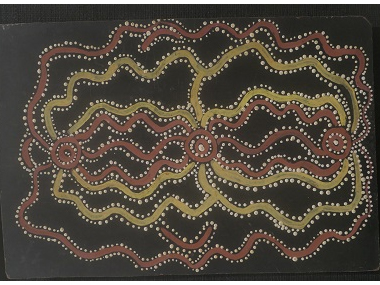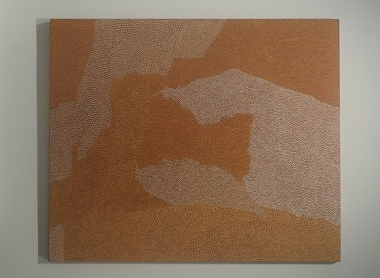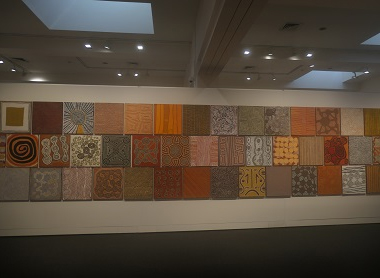PAPUNYA ART AT 50

The 'Water Dreaming' from 1972 by Old Walter Tjampitjinpa, the man who'd authorised the Papunya school mural designs
Posted by Jeremy Eccles | 08.03.21
Dates:
27.02.21
: 04.04.21
Location: Observatory Hill, Sydney
Back in 1971, a revolution took place at the most unlikely place. The remote, government-built desert community of Papunya was full of Pintupi, Warlpiri, Luritja, Aranda and other tribespeople who were increasingly reluctant to meet the official deadline for assimilation. They knew they had strong culture and law of their own and didn't need the whitefellars' versions. But the importance of secrecy in their culture – even amongst non-initiates from their own language group – had encouraged a reluctance to reveal all.
Now, as a result of a variety of factors (best explained in the superb 'Tjungungutja' catalogue from the Museum and Art Gallery of the NT) they decided on a last ditch effort to unveil their inner strengths in a visual way. Yes, the late Geoffrey Bardon was an inspiration in encouraging his school pupils to paint in “an Aboriginal way”; and then to allow mature men to paint a mural or two on his school's walls. But several of them had had earlier experience of the Yuendumu Men's Museum which introduced the idea of bringing art and artefacts in from distant ceremonial sites now that tribal people had been pinned down in residential communities. And a pocket dynamo like Kaapa Tjampitjinpa had already had his painting shown successfully in the Alice Springs Art Prize.
That this quiet and largely unsuccessful revolution – for few wanted to buy this 'art' that wasn't as ethnologically pure as the barks of Arnhemland and was using whitefellars' acrylic paints not ochres – should go on to be hailed as “the last great art movement of the 20th Century” by the great Robert Hughes (though no one has produced proof that he actually committed himself to this quote) is little short of a miracle. The Heidelburg School and the Angry Penguins are the only possible comparisons in Australian art.
And the ramifications of this revolution – which slowly spread out of the deserts to The Kimberley and then back down to the reluctant Pitjanjatjarra lands – have been enormous. Status was given back to community elders; money was earned that wasn't just 'sit-down' funds; younger generations were re-introduced to the stories that had sustained their people for aeons; whitefellars were able to invest in a tentative understanding of First Nations culture; the whole politics of Indigenous Australia were set to move.
And yet, 50 years on, no major Aussie art institution is celebrating! I can find no plans for a major exhibition, and Papunya Tula Artists – the first community art centre that became a model for the many that now exist around the country – tells me, “Nothing concrete (by way of a celebration) at this stage. Things may take shape later in the year”.
Perhaps it doesn't help that PTA was actually founded in November 1972 – pretty fast after the art started flowing, but not in 1971. And surely that speed reveals just how strongly the artists felt about the collaborative nature of their enterprise and the need to control it themselves. As a result, PTA the organisation has often been conflated with the art movement – as in the Art Gallery of NSW's 2000 Olympic exhibition, 'Papunya Tula – Genesis and Genius' and Vivien Johnson's magisterial book, 'Lives of the Papunya Tula Artists'.
So it's not surprising that the only exhibition to note this major development in Australian art is questionably called 'Papunya Tula : 50 Years'. It's just opened at the excellent SH Ervin Gallery in Sydney, and is curated by commercial galleryist Christopher Hodges, whose Utopia Art Sydney gallery has been displaying and selling PTA art since 1988. This long association has allowed access to private collections across Australia for the exhibition, pulled together at a time when institutional loans have been tricky thanks to the pandemic.
Sadly, it's not really the exhibition that the occasion deserves. There's no catalogue and little attempt to contextualise the art or the history. The only map on show seems to suggest that Papunya is still the fulcrum of the painting when, in fact, the artists have moved on to points further west that don't even appear on the map. Also, compared to major gallery shows such as 'Tjungungutja' in the NT, the AGNSW show and 'Tjukurrtjanu' in Melbourne, the quality of the work on show is barely top rank. To begin, for instance, viewers are greeted by an undated mid-career Anatjari Tjakamarra on arrival when his earliest works pioneered the square in Papunya painting and surely deserved a place here. And then we leap to mighty contemporary works by Yakultji Napangati and George Tjungarrayi in the current op-art style as though there was nothing in between.
Yes, there are some fine early boards, so easily dismissed by the market early on until Sotheby's auction house dug them out and earned their owners (not the artists) six figure sums. A tiny jewel by Charlie Egalie from 1976 shows that not all artists leapt into canvas when PTA started offering them, using colours that feel straight out of the deserts. A lovely Old Walter Tjampitjinpa captures all the flow of a classic water dreaming without a hint of blue or green. Next door is a frankly phallic Billy Stockman 'Untitled' 1971. And a poetic Mick Namarari is given the title (did he call it this?), 'Kangaroos Sleeping in the Rocks'.
But who might subtitle a work from this era, 'Fear'? Surely only the inventive Charlie Tjaruru, who would have the first solo show by a Papunya artist in 1987 and later go on to work with Marina Abramovic no less, and possibly introduce her to the idea of silent contemplation of another. In 1978, he painted 'Fear and Cold' which was associated with the mythology of the Iceman of Tjitururnga. Tjaruru's 1990 work in the SH Ervin is another experiment, whiting out a series of linked circles in a manner later employed by Billy Thomas in Kununurra.
His 'Special Yam Dreaming : Fear' appears on a strong wall featuring early works by super-stars Kaapa Tjampitjinpa, Uta Uta Tjangala and a 'Water Dreaming' by Johnny Warangkula.
As we progress through the years – though not necessarily chronologically around the gallery's walls - an undated and untitled Namarari colour-field work is surely one of his well-known 'Marsupial Mouse Dreamings', there's a classic Ronnie Tjampitjinpa from 1989 and three mosaic works from the 80s by Uta Uta Tjnagala, Joseph Jurra and 'Nolan' Tjapangati. I suspect he's better known as Billy Nolan; just as 'Tjinkiya' Napaltjarri is generally called Tjunkiya – one of the strongest woman's work in the show. Mind you, there's a super Doreen Reid Nakamarra, whose mesmeric sandhills might have shown up even better laid flat – as they were in a recent Biennale of Sydney.
Meanwhile, two huge walls are taken up by a slew of small canvases of the sort that I associate with being painted for the Christmas market. It certainly offers a picture of the variety of patterning that exists today in Papunya art, and, gives a presence to the younger artists; but it would be surprising if anything that restricted could achieve the depth that a large canvas offers a senior artist.
So, congratulations to the National Trust at SH Ervin and Chris Hodges for bringing this important anniversary to our attention. Hodges is quoted as explaining, “It’s a unique collection of over 80 artists that reveals breadth of talent and participation. It shows an art movement shifting across generations, familial connections, and history”. I just wish Hodges had had the resources that a major institution might have offered to carry this celebration off more effectively.
I've just recalled that the SH Ervin Gallery has a heroic history in the Indigenous art field. They showed the first exhibition of paintings out of Utopia in 1989, Rodney Gooch's 'Summer Project', which introduced the world to the immortal Emily Kngwarreye.
URL: https://www.shervingallery.com.au/event/papunya-50-years/
Share this:
»  del.icio.us
»
del.icio.us
»  Digg it
»
Digg it
»  reddit
»
reddit
»  Google
»
Google
»  StumbleUpon
»
StumbleUpon
»  Technorati
»
Technorati
»  Facebook
Facebook
Contact Details

Mick Namarari's luminous 'Marsupial Mouse Dreaming' (undated)

The wall of smaller works that have allowed a young generation of PTA artists to move into the market
Further Research
Artists: Anatjari Tjakamarra | Billy Nolan Tjapangati | Billy Stockman | Billy Thomas | Charlie Egalie | Charlie Tjaruru | Doreen Reid Nakamarra | Emily Kngwarreye | George Tjungarrayi | Johnny Warangkula | Joseph Jurra | Kaapa Tjampitjinpa | Mick Namarari | Old Walter Tjampitjinpa | Ronnie Tjampitjinpa | Tjunkiya Napaltjarri | Uta Uta Tjangala | Yakultji Napangati
News Tags: Christopher Hodges | Geoffrey Bardon | Jeremy Eccles | Marina Abramovic | National Trust | Papunya Tula Artists | Robert Hughes | Rodney Gooch | SH Ervin Gallery
News Categories: Australia | Blog | Exhibition | Feature | Industry | News
Exhibition Archive
- 16.03.21 | The Very Late Charlie Flannigan
- 08.03.21 | PAPUNYA ART AT 50
- 19.02.21 | National Endowment for Indigenous Visual Arts
- 11.01.21 | "Lost in Another Person's Culture”
- 04.01.21 | Appreciating Mparntwe
- 09.12.20 | Museological Sydney
- 02.12.20 | Getting Back into the Habit in Sydney
- 25.11.20 | VICTORIA OPENS!
- 17.11.20 | Aboriginal Art Storms Online
- 10.11.20 | 'Nilimurra Dhuwal: Here We Are' by Guynbi Ganambarr
- 06.11.20 | GORDON BENNETT SOLO IN QUEENSLAND
- 28.10.20 | The 'Seven Sisters' Heading for England
- 28.10.20 | $80K Across Seven Awards - The Big Telstra Open for Entries
- 13.10.20 | The Ebes Collection
- 12.10.20 | Sun Shines on the Wiradjuri Festival
Advertising

